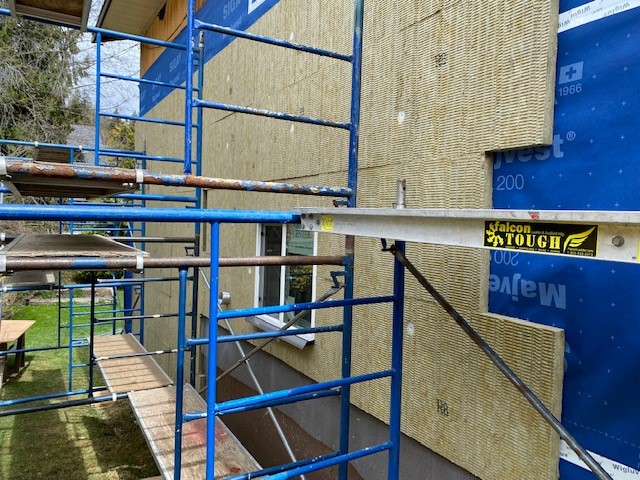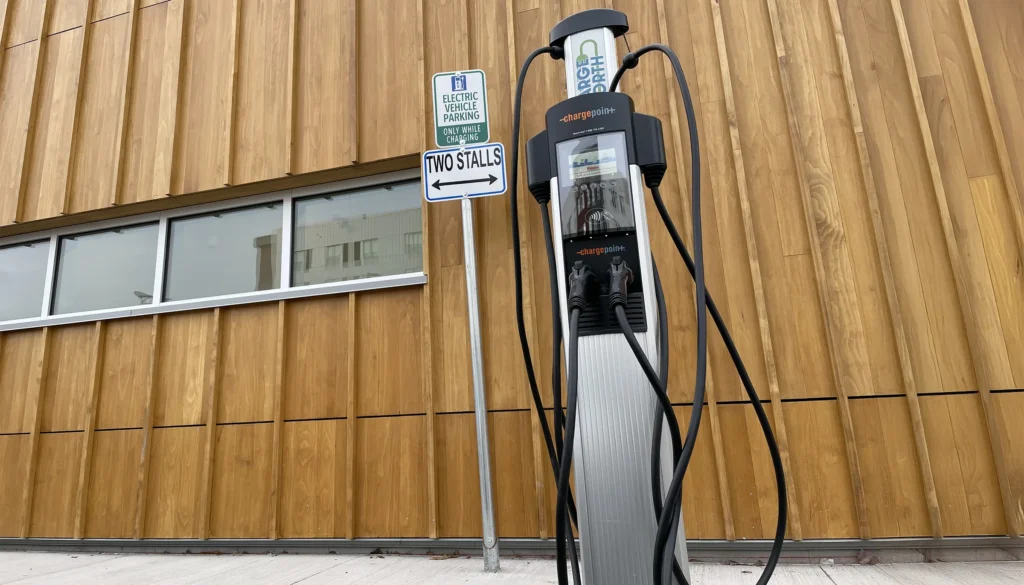
Power to Act:
BC communities have shown real leadership on climate, but most still aren’t on track to meet their climate targets.
Some of the most effective climate tools available to municipalities are regulatory, like zoning bylaws, development permits, and covenants. These tools are powerful, enforceable, and already enabled by provincial law. Yet many remain underused.
The gap isn’t ambition, it’s implementation.
That’s where Power to Act comes in.
This tool helps municipal staff and elected officials use their available but underutilized regulatory powers to advance efficient electrification and achieve their climate goals. It offers practical, legally vetted guidance tailored to BC’s legal context and the realities of BC local governments, both large and small.
If you’re trying to figure out how to reach your community’s climate goals, Power to Act helps you make the connections between:
- Climate Objective – What you want to achieve (e.g., more EV charging)
- Regulatory Tool – What BC law allows (e.g., bylaws, covenants, phased development agreements, zoning)
- Regulatory Pathway – How to make it work in practice
Ready to act? Start by exploring the sectors where your community wants to make progress.
Explore pathways by sector

Mobility
Local governments can increase low-carbon transportation by requiring EV charging infrastructure and encouraging car-sharing.

New buildings
Local governments can shape new developments to meet higher energy efficiency and emissions standards.

Existing buildings
Local governments can drive improvements to the existing building stock with local retrofit requirements, energy performance standards, and other policies and incentives.
Why focus on regulations?
In BC, buildings and transportation make up over 60% of community emissions. These are also areas where local governments have the clearest authority, and the strongest tools, to create change.
Many municipalities have already launched programs, enacted policies, and deployed infrastructure—like high-performance building incentives and public charging networks—to tackle these emissions, but a gap still remains.
That’s where regulation comes in.
Local governments can adopt legally enforceable rules, such as zoning bylaws, development permits, and building standards, to guide land use, construction, and infrastructure in climate-aligned ways. Unlike incentives, these tools require compliance and apply consistently to all applicable developments or activities.
Put simply, it’s the difference between saying “we encourage this” and “this is the standard.”
Regulatory tools are powerful because they:
- Offer clear, enforceable mechanisms to drive change
- Provide market certainty and consistency across jurisdictions
- Enable action at the scale needed to meet climate goals
This tool helps navigate uncertainty around authority and application, especially where local governments have faced conflicting legal advice or staff interpretations.
How was this tool developed?
This resource is grounded in:
- A legal review conducted by Lidstone & Company, a BC-based law firm specializing in municipal law
- Insights from a Community Energy Association-led advisory group of local government staff and subject matter experts
- Best practices and emerging trends from local governments across BC and Canada
Each regulatory pathway links to its underlying legal analysis in Lidstone & Company’s memorandum. Read about the research process, legal review, and advisory group.
Help shape the future of this tool
CEA will periodically update this tool to include new objectives, pathways, resources and case studies. Have a suggestion or feedback?
How to navigate
- Start with what matters to your community: Want to reduce fossil fuel use in new developments or support EV adoption? Browse by Sector to find the tools that fit your goals.
- Understand your options: Curious about the difference between a development permit area and a covenant? Use the Tool Glossary for context and constraints.
- Check legal feasibility in your context: Every pathway links to the Lidstone legal memo, so you can assess authority and risks with confidence.
Mobility
Local governments have several legal tools to advance climate action in the mobility sector, particularly by expanding electric vehicle (EV) infrastructure and promoting sustainable transportation. Key strategies include mandating EV readiness in new developments to reduce future retrofit costs, leveraging transportation demand management bylaws to require charging infrastructure, and using covenants with developers to secure EV-ready parking and curbside charging. Additionally, municipalities can offer density incentives through amenity zoning, require EV infrastructure in phased development agreements, and lease public land for charging stations. Car-sharing can also be supported through development covenants that allocate parking for shared vehicles. These regulatory pathways provide local governments with clear mechanisms to accelerate the transition to low-carbon.
Objectives for advancing climate action in mobility

EV-ready building requirements
Installing EV charging in multi-family buildings after construction can be costly and technically difficult—especially in underground parking. By requiring EV readiness or charging infrastructure upfront, local governments can avoid expensive retrofits, promote equitable access to charging, and support the shift to electric vehicles.
Many B.C. local governments already require EV readiness as part of their zoning or parking bylaws, using their authority to regulate parking design. This is currently allowed because EV charging infrastructure falls outside the scope of the BC Building Code.
Looking ahead, the Transportation Demand Management (TDM) Bylaw offers a new and promising tool for implementing these requirements. While there’s no indication that existing EV Ready bylaws need to be changed to fit under TDM powers, local governments may choose to transition over time.
In all cases, it’s important to follow best practices, such as those outlined in EV Ready New Construction Requirements: Best Practice Guide for B.C. Local Governments (V2), and to plan for updates as technology evolves.
Other regulatory tools—such as covenants, phased development agreements and amenity zoning—can also be used to secure EV readiness. However, because these tools are applied on a parcel-by-parcel basis, they require more administrative effort.

Curbside charging
Curbside EV charging stations, typically located in the public right-of-way, provide charging that is accessible and available to the public. These stations are especially important in high-density areas and near multi-family buildings, where private parking and charging are limited.
Expanding curbside charging is a key strategy for making EV ownership more accessible and equitable. Several of the same regulatory tools used for EV Ready building requirements—such as covenants, phased development agreements, and amenity zoning—can also support curbside charging. These tools are well suited for major developments and can be applied on a case-by-case basis, particularly in areas adjacent to existing multi-family housing. In addition, local governments that own street frontage or other public land can lease or license space to enable the installation of curbside charging stations.

Car sharing
Car sharing is a car rental service that allows people to use vehicles for short periods of time, often by the hour. It can be an economical and eco-friendly option for those who only need occasional access to a vehicle. Local governments may want to enable car sharing in large new developments to support mode shift and reduce car ownership as part of a broader transportation demand management strategy. Car sharing generally requires agreements with car share providers and the market for car sharing varies by community.
New buildings
Regulating new construction is one of the most effective ways for local governments in British Columbia to advance climate goals. Unlike existing buildings, new developments can be shaped from the outset to meet higher energy efficiency and emissions standards. The BC Building Code (BCBC) sets the foundation, but local governments have several tools to go beyond minimum requirements. Many are advancing climate priorities by adopting the Zero Carbon Step Code and higher steps of the BC Energy Step Code, integrating energy labelling and benchmarking into permitting processes, or using incentives like density bonuses and floor space ratio (FSR) allowances to encourage low-carbon building practices. Some communities are also leveraging development permit areas to require enhanced performance standards. As climate policies evolve, local governments are increasingly using a mix of regulatory and incentive-based approaches to drive efficient, low-emission new construction.
Objectives for advancing climate action in new buildings

Require energy reporting and disclosure for new Part 3 buildings post-occupancy
Energy reporting and disclosure, also known as energy benchmarking, is the practice of measuring a building’s energy use over time and comparing its performance to similar buildings. For new construction, it offers a way to assess whether a building performs as intended once it’s occupied—bridging the gap between design-stage energy modelling and real-world outcomes.
Unlike energy code compliance, which relies on simulations conducted before construction, post-occupancy reporting and disclosure reveals how a building actually operates. It can help identify inefficiencies, inform performance improvements, and support long-term planning for retrofits and emissions reductions.
Because energy reporting and disclosure requires at least 12 months of utility data, it applies after a building is operational. This means it cannot be used to regulate the construction phase, but local governments can still require energy performance reporting after a defined period of occupancy. Doing so supports both climate targets and asset management goals, while staying within the limits of the Building Act.
To support implementation, local governments can refer to the Step-By-Step Guide: Supporting Local Governments in British Columbia to Implement Energy Benchmarking, which provides detailed guidance on program design, data access, and stakeholder engagement.

Require commissioning of new buildings
As new buildings become more complex—with integrated systems for heating, cooling, ventilation, lighting, and water—commissioning has become a critical step to ensure these systems work together efficiently. Commissioning is a quality assurance process that begins during design and continues through construction and early occupancy. It verifies that systems perform as intended and helps building operators maintain long-term energy efficiency and occupant comfort.
The benefits of commissioning include reduced greenhouse gas (GHG) emissions, lower operating costs, and better-performing buildings. For local governments in B.C., requiring commissioning can be an effective way to ensure that climate and performance goals are met from day one.
Local governments can require commissioning through three main pathways. The most direct approach is enacting a bylaw under section 8(3)(l) of the Community Charter, though this may raise questions under the Building Act unless ministerial approval is obtained. Alternatively, commissioning can be secured through section 219 covenants, applied on a parcel-by-parcel basis during rezoning or permitting. Where the local government owns the land, commissioning requirements can also be included in development agreements, leases, or licenses.

Limits on new natural gas servicing and connections
To meet climate targets and reduce long-term reliance on fossil fuels, many BC municipalities are exploring strategies to limit or phase out new natural gas servicing in buildings. These approaches favour all-electric designs or on-site renewable energy systems and are motivated by concerns over future stranded gas assets, shifting regulatory landscapes, and the need for resilient infrastructure.
While the Building Act limits municipal authority over technical building systems, municipalities can still influence mechanical system choices by adopting the Zero Carbon Step Code (ZCSC), a performance-based compliance path that sets greenhouse gas intensity (GHGI) limits for new buildings. Higher steps in the ZCSC effectively require electric systems in most cases, providing a clear policy lever within provincial jurisdiction. Municipalities can further support the transition through legal and planning tools that target servicing, infrastructure, and development approvals.
Municipalities may designate Development Permit Areas (DPAs) to encourage energy conservation and GHG reduction, allowing regulation of external features like heat pumps and solar collectors. They may also negotiate section 219 covenants during development approvals that commit developers to avoid fossil fuel systems or prioritize electric heating. Additionally, local governments have the option of pursuing public franchise agreements under section 22 of the Community Charter to restrict new gas servicing, though this path is legally untested and may prompt utility opposition.
When combined with ZCSC adoption, these tools offer a layered and flexible strategy to transition new development away from natural gas while remaining within provincial jurisdiction.

Zoning bylaw to regulate fossil fuels
Municipalities in BC have zoning powers that can be used to limit or prohibit land uses related to fossil fuel production, processing, and retailing. These powers allow local governments to shape how land is used in ways that align with climate objectives, particularly by discouraging or preventing new fossil fuel infrastructure in their communities.
Under section 479 of the Local Government Act, municipalities may enact zoning bylaws that prohibit specific land uses, including those involving the sale or processing of fossil fuels, where such uses are deemed incompatible with long-term land use plans or climate goals.
Local governments may also negotiate section 219 covenants during rezoning processes, securing voluntary agreements from landowners to limit fossil fuel-related uses in future developments. While covenants offer flexibility, their applicability may be more limited under recent legislative changes such as Bill 44, which allows small-scale multi-unit housing up to 4 or 6 units on residential lots that were previously zoned for single-family homes, and Bill 47, which restricts rezoning discretion in areas designated as transit-oriented areas.
Existing buildings
Unlike new construction, existing buildings present a greater challenge for regulation, as there is currently no provincial code equivalent to the BC Building Code for retrofits. A national Alterations to Existing Buildings (AEB) Code is in development, and BC has signalled its intent to adopt it, but the timeline and application remain uncertain. In the absence of a standardized framework, local governments have taken the lead by implementing programs to support building retrofits. However, to accelerate decarbonization, stronger policies and regulations are needed to provide clear guidance and market certainty for the industry. Moving forward, local governments are exploring ways to introduce retrofit requirements, energy performance standards, and disclosure policies to drive improvements in existing buildings and support the transition to a low-carbon future.
Objectives for advancing climate action in existing buildings

Require energy and emissions benchmarking for existing buildings
Benchmarking is the practice of measuring and tracking a building’s energy performance over time and comparing it to similar properties. Local governments across British Columbia are increasingly interested in implementing benchmarking and reporting requirements for subsets of the building stock as an initial step toward enabling energy retrofits and broader climate action.
Whether required by law or adopted voluntarily, benchmarking measures a building’s actual performance over time, relative to itself and to other similar buildings. It is distinct from energy code compliance, which is based on modelled simulations; however, benchmarking data can inform future compliance evaluations and help prioritize retrofit opportunities.
Many BC local governments have begun exploring benchmarking, reporting, and disclosure as part of their decarbonization toolkit. Building Benchmark BC, a voluntary initiative led by multiple jurisdictions, has laid important groundwork for a future transition to mandatory reporting.
Local governments considering regulatory approaches should also take steps to build a supportive enabling environment, including stakeholder engagement, data infrastructure, and legal clarity.

Require oil tank removal
Home heating oil systems are among the most carbon-intensive residential heating options and pose environmental and safety risks due to potential soil and groundwater contamination from leaking tanks. To support climate action and environmental protection, local governments in British Columbia are exploring pathways to require the removal of home oil tanks and promote low-emission alternatives such as electric heat pumps.
Municipalities may leverage Development Permit Areas (DPAs) designated for energy conservation or GHG reduction to require connection to a non-oil heating system when a property undergoes major alterations, additions, or new construction. These requirements must be tied to external systems or features, as local governments cannot regulate internal building systems under the Building Act. Alternatively, municipalities may establish local service areas to offer financial assistance or on-bill financing for oil tank removal and replacement, potentially supported by federal or provincial grants and collected through property taxes.
Finally, a municipality may pursue a bylaw mandating oil tank removal under the Community Charter’s environmental or public health authorities. However, because these fall under spheres of concurrent authority, ministerial approval is required. A successful application would need to demonstrate evidence of environmental or health risks from oil tank leakage. Taken together, these tools provide a strategic mix of incentives, conditions, and potential mandates to phase out heating oil and reduce emissions from the residential building sector.

Retrofit incentives
Municipalities can support energy efficiency and emissions reductions in existing buildings by facilitating retrofit financing through a Local Service Area. With homeowner approval, this mechanism allows the municipality to fund upgrades, such as heat pumps, insulation, or solar panels, using external grants or loans, and recover costs over time via parcel taxes on participating properties. This approach helps reduce upfront costs for homeowners and enables a structured, community-scale retrofit program aligned with climate goals.

Cooling requirements
Extreme heat events have highlighted the need for cooling in residential buildings, especially for vulnerable populations. Local governments in British Columbia have two primary tools to require or enable cooling, one for rental properties and one for buildings applying for building permits to undertake a major retrofit.
Municipalities and regional districts can adopt a Standards of Maintenance Bylaw under the Community Charter or Local Government Act to require landlords to provide cooling in rental units or permit tenants to install mobile cooling devices.
Local governments can apply Section 9.33.3(2) of the 2024 BC Building Code to buildings undergoing retrofits that require permits, thereby ensuring at least one room maintains indoor temperatures below 26°C. While this does not mandate heat pumps, it creates a performance requirement that can often be met through electric cooling systems. These tools offer municipalities a path to improve tenant safety and climate resilience in both existing and upgraded housing.